4 Bedroom Home Floor Plans
The kitchen is usually the busiest room in any home, so you need durable, easy to live with flooring which looks good. If you're renovating your home and need some kitchen flooring advice, these kitchen floor ideas will help you with your next project.
When it comes to kitchen flooring, budget is a key factor; vinyl is a good choice for the cost-conscious, but engineered wood is a bigger investment.
Take into account the size of the space. In a smaller kitchen, for example, larger tiles (600mm x 600mm or 800mm x 800mm) mean fewer grout lines, so the area looks larger, says Ben Bryden, sales and marketing director, RAK Ceramics UK.
You can opt for a kitchen floor that makes a statement and sets the visual tone of your home, or as interior designer David Conlon, founder of En Masse Bespoke, suggests, use the kitchen floor to create a coherent approach to your whole downstairs space, extending the look out to the garden patio if possible: 'It's important to keep the flow. Even if it's a different flooring from room to room, work with the colour.'
Kitchen floor idea 1: Tiles
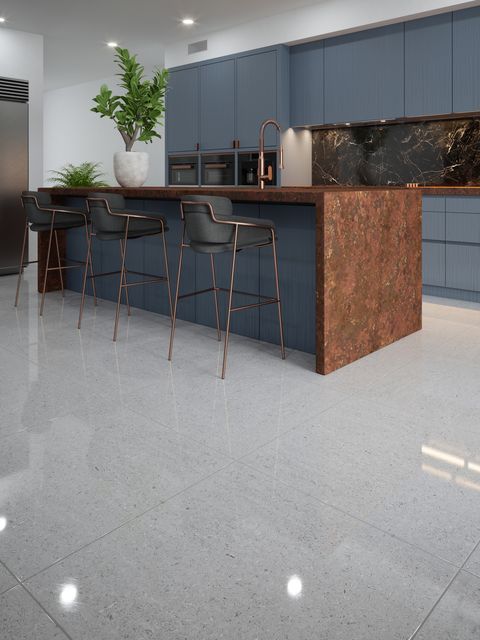
Wall and Floors
Porcelain tiles are very easy to maintain so make a great kitchen choice. They are usually less expensive than stone or ceramic – they demand less attention than stone and are more hard-wearing than ceramic. 'There's also lots of grouting colour options now,' says designer Emily Black at Emily May Interiors. 'Mid-dark colours work better on floors as dirt can get ingrained.'
Available in a vast range of colours, textures and sizes, it's easy to achieve the look you're after with porcelain tiles – whether contemporary gloss, rustic planks, textured stone-effect or vintage geometric prints. In a smaller kitchen, pale shades of porcelain will encourage light to bounce around, making the space feel larger.
Modern technology means porcelain is now resilient enough to be used outdoors too, so it's ideal for a kitchen leading to a garden, says Jo Oliver, director at The Stone & Ceramic Warehouse: 'Porcelain is a great choice for this as it is virtually indestructible.'
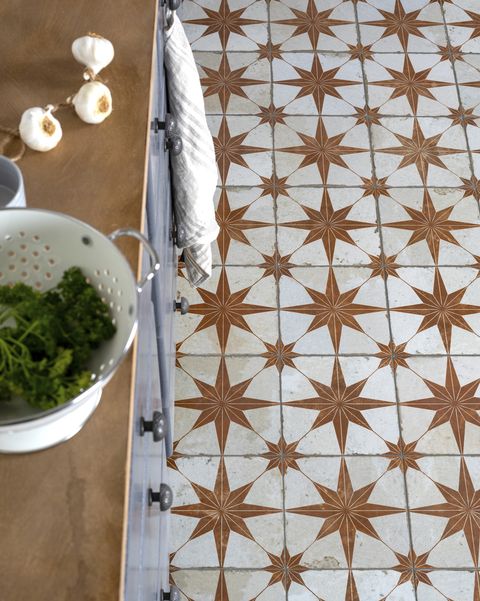
Walls and Floors
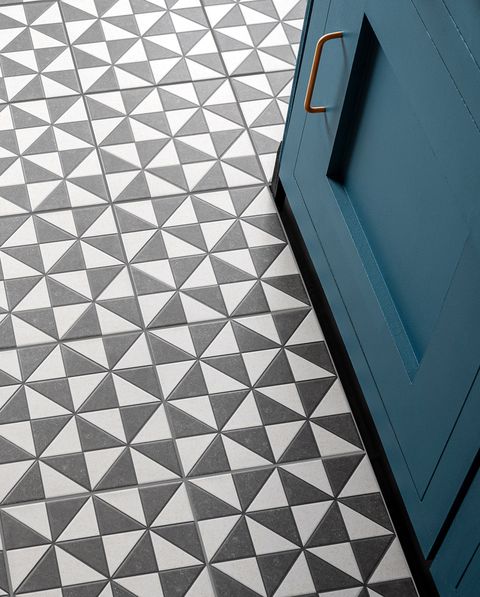
Pros
• Resists stains.
• Lightweight and easy to handle.
• Can be laid in creative shapes – such as hexagons and rectangles – and different laying patterns, for example, straight, brick-bond, parquet and herringbone, to create the look you want.
• Borders can be added for extra definition.
Cons
• Often cold underfoot, so works best with underfloor heating.
• You'll need to allow for wastage, so add an extra 10 per cent to the measurements, rounding up to the next box.
Kitchen floor idea 2: Vinyl

There's a vinyl for every budget, from less than £10 per sqm to luxury vinyl tiles (LVT), which are designed with several layers of 'cushion' for a softer feel and a longer life.
Vinyl is a very practical choice as it's designed to withstand all the rigours of daily life. 'Kitchens are the heart of the home and the flooring must provide a strong foundation that almost looks after itself,' says Johanna Constantinou, brand director at Tapi carpets and floors. 'So you don't panic over spills, dropped pans, water, leaks and heat, choose a really tough flooring like vinyl or LVT.'
Johanna says that the big trends this year are stone or concrete-looks: 'These only used to be achievable at huge expense but now, LVTs can create the desired look with extra feel appeal and comfort.'
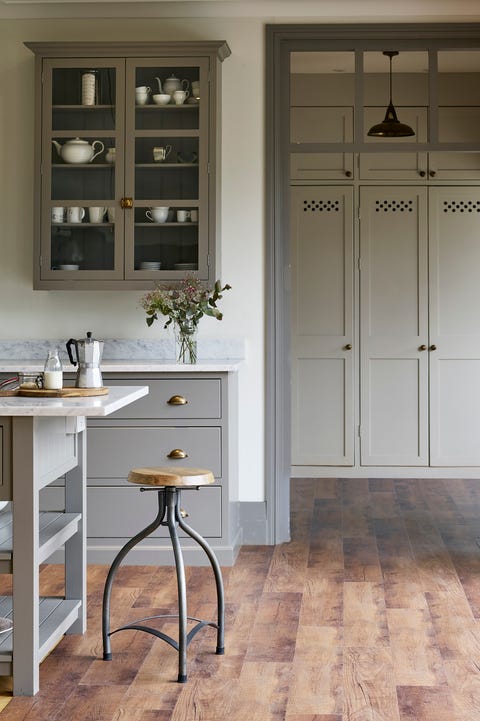
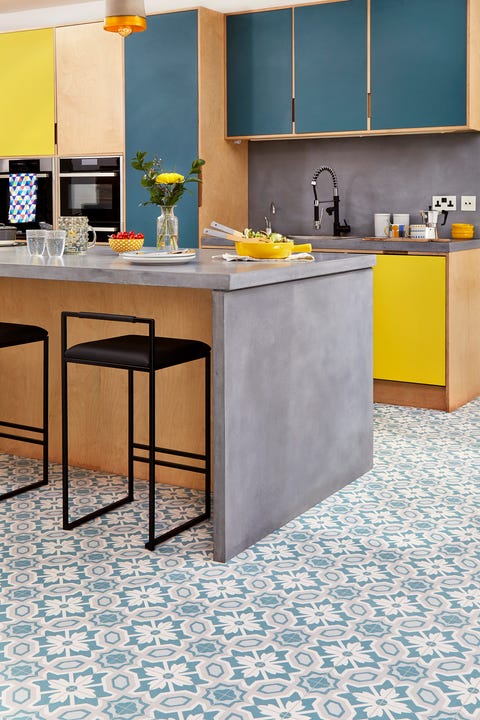
Loop Photography/Lifestyle Floors
Pros
• Huge choice of styles and pricing.
• Can be laid by a decent DIYer, over existing ceramic or porcelain tiles.
• Warm underfoot.
• Good for acoustics and to reduce 'echo' in a larger kitchen.
• Easy to swap when you fancy a new look.
• Very forgiving if you're a clumsy cook – plates are less likely to break on vinyl than porcelain, and neither will you crack a tile, says William Durrant, founder and director, Herringbone Kitchens
Cons
• Ideally, the floor underneath (substrate) needs to be completely flat and smooth. Bumps will be reflected in the surface of the flooring. Julia Trendall, flooring expert at Benchmarx Kitchens, usually recommends a variance of no more than 3mm, over a three-metre span. It may be necessary to lay a levelling compound, typically a job for a professional vinyl tile fitter.
• Check for damp before laying vinyl. You may need to lay a damp-proof membrane or moisture-suppressent layer, but take professional advice from a specialist company such as Rentokil.
Kitchen floor idea 3: Laminate
New technologies mean it's hard to tell some laminates apart from engineered hardwood flooring, meaning you can have the premium look and benefits of added durability for less spend.
Laminate flooring is made from layers of MDF (medium density fibreboard) imprinted with a realistic pattern, followed by a hard-wearing and ideally, scratch and stain-resistant surface.
The biggest problem is water. Laminate can be ruined by the smallest amounts of liquid, just from wet shoes or washing the dishes. So look for a brand which uses a hydro-seal system, says David Snazel, buyer, hard flooring Carpetright. 'This extends the life of the product by keeping water out. It helps to prevent the water from penetrating past the top layer and seeping into the MDF which will expand and "blow".'
Pros
• Good low-cost options available.
• Modern designs look very realistic and resemble 'real' wood, stone, or even concrete.
• An easy choice for a smaller kitchen, or one which doesn't receive heavy traffic.
• Fairly easy to install and take up again when you fancy a change.
Cons
• The pattern layer can wear off quickly, so choose the best quality you can afford.
• Have it professionally-fitted if possible. The finish can make all the difference, even to a cheaper laminate.
• Not ultra-hardwearing and easily spoiled by water.
Kitchen floor idea 4: Wood

Real wood flooring is both beautiful and practical, but always opt for engineered rather than solid hardwood, says Peter Keane, director of The Natural Wood Floor Company.
Engineered wood flooring will withstand a kitchen's changes in temperature, humidity and moisture, thanks to the way it is constructed. The top layer of the plank is real hardwood, underneath layers of plywood provide dimensional strength and stability. It's also suitable for use with underfloor heating, but always check with manufacturers first.
It's very versatile too. Achieve a rustic look with wide planks and a wood with lots of variations, or opt for a streamlined polish with a closer grain.
You might like to consider reclaimed wood flooring, says Alex Main, director of reclaimed kitchen and flooring supplier, The Main Company. 'This is not only eco-conscious, but introduces authentic charm to the kitchen. No piece of wood is identical and therefore no kitchen using reclaimed wood will be either.'
However, bear in mind the issues around humidity, expansion and contraction, and don't expect perfection.
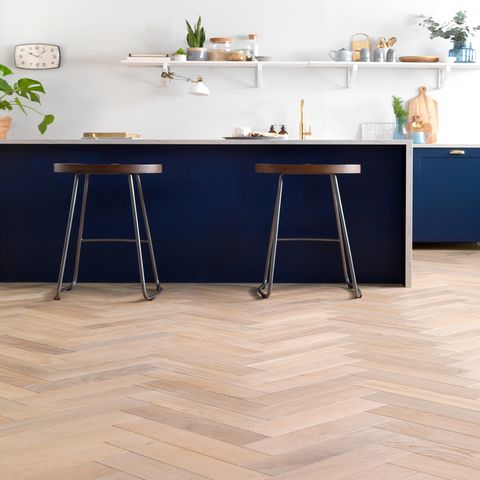
Pros
• Hard and shiny kitchen surfaces are instantly 'softened' with a wood floor, giving the room balance and making it look more homely, says David Papworth, general manager at wood specialists, Junckers.
• Muddy footprints and spillages are taken care of easily with a gentle mop and some mild detergent.
• An engineered wood floor can be sanded down and refinished numerous times over its lifespan, so you can create a new look if you like.
• Most wooden floors are fitted as floating floors and need a dry and level surface underneath.
Cons
• It will need maintenance. Choose a lacquered finish. It's harder-wearing than oil – shield the wood at surface-level so liquid and stains are repelled.
• There can be natural variation plank-to-plank, especially noticeable across a large space. A top tip, says Julia Trendall at Benchmarx Kitchens, is to open around three boxes at a time and select planks from each pack. This will give a more varied look and avoid areas with lighter or darker tones.
• You'll need to keep your kitchen well-ventilated, says Darwyn Ker, managing director at Woodpecker Flooring. 'Wood naturally expands and contracts as heat and moisture levels rise and fall. Heat and steam from cooking can cause large fluctuations in the kitchen. Keep control of these changes to ensure your wood floor stays in tip-top condition. Fit an extractor fan and open a window when cooking.'
Kitchen floor idea 5: Lino

Lex20 Getty Images
Linoleum – or lino for short – is an authentic addition to the kitchen in any period home and is a good choice if you favour natural and sustainable materials. Invented in Victorian times, it's made from a by-product of wood, ground limestone, powdered cork, pigments, jute and linseed oil.
Most of us are familiar with that vintage black and white checkerboard design, but lino is now available in a wide range of colours and patterns. It's available on a roll – professional fitting is recommended for this –or in individual tiles, which are fairly easy to lay yourself. Forbo Flooring, which has an online retailer locator for its range of Marmoleum tiles, is around £50 sqm, plus fitting costs.
Pros
• Easy to clean, just swipe it over with a damp mop.
• A great cost-effective option, especially if you like changing your mind every couple of years.
• Lots of patterns available – wood, geometric, even floral!
• Vast range of quality available, higher-end, thicker lino or roll vinyl as it's also called, will last longer if your kitchen doesn't have heavy use.
• Minimal sub-floor preparation needed, no damp test needed.
• Lino tiles can be quickly replaced if damaged.
Cons
• Avoid if you have dogs (because of their claws) and avoid wearing high heels indoors. High pressure in a small area will pierce the surface.
• If the sub floor is rough, it will show through. You may need to lay a latex screed. Seek professional advice on this.
• Can tear easily.
Kitchen floor idea 6: F loor mats, rugs and runners
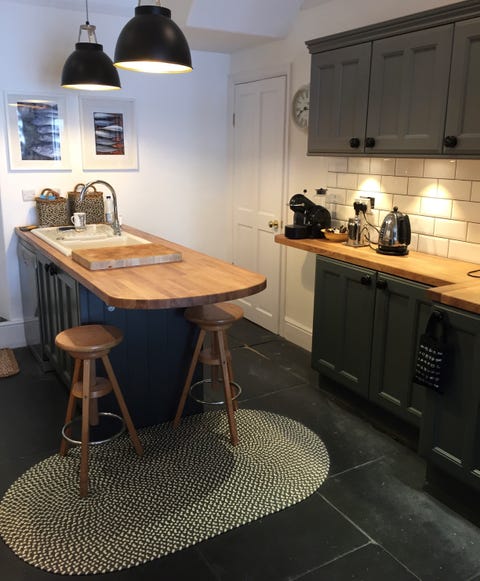
Rugs and runners introduce colour and texture into the kitchen, says Julian Downes, managing director of flooring and rugs company, Fibre. 'On-trend colour pops can be experimented with and easily moved around or changed without too much cost or upheaval.'
Mike Richardson, general manager at Kersaint Cobb, recommends a striped runner to make a narrow kitchen look larger by drawing the eye outwards to the edges of the room. You could also choose a chevron or a diamond pattern to create visual interest and distract attention from the limited proportions.
Pros
• Natural materials such as sisal don't hold static electricity or gather dust particles, so good for allergy sufferers.
• Washable mats, rugs and runners can be vacuumed quickly or easily popped in the washing machine for regular hygiene updates, especially if there are young children and/or pets in the home.
• 'Runners and rugs are a great addition to section-off areas in large rooms, especially if you have an open-plan kitchen in the reception room,' says Andrew Weir, chief executive of property and design company LCP.
• Fabrics bring texture and warmth to a kitchen, so can provide a stylish offset to a sleek and shiny modern look.
Cons
• Can be a trip hazard, so always secure to the floor with adhesive rug tape.
• Too many mats, rugs and runners can look disjointed, so choose one or two at most to enhance your kitchen space.
Like this article? Sign up to our newsletter to get more articles like this delivered straight to your inbox.
SIGN UP
Love what you're reading? Enjoy House Beautiful magazine delivered straight to your door every month with Free UK delivery. Buy direct from the publisher for the lowest price and never miss an issue!
SUBSCRIBE
This content is created and maintained by a third party, and imported onto this page to help users provide their email addresses. You may be able to find more information about this and similar content at piano.io
Source: https://www.housebeautiful.com/uk/decorate/kitchen/a35693910/kitchen-flooring/

0 Komentar